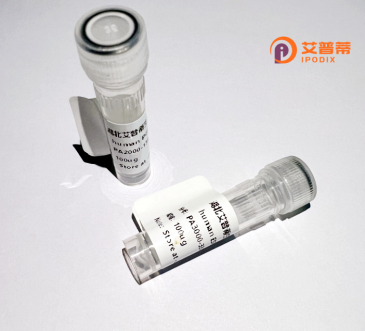
| 纯度 | >90%SDS-PAGE. |
| 种属 | Human |
| 靶点 | FBXO10 |
| Uniprot No | Q9UK96 |
| 内毒素 | < 0.01EU/μg |
| 表达宿主 | E.coli |
| 表达区间 | 1-956aa |
| 氨基酸序列 | MEAGGLPLELWRMILAYLHLPDLGRCSLVCRAWYELILSLDSTRWRQLCLGCTECRHPNWPNQPDVEPESWREAFKQHYLASKTWTKNALDLESSICFSLFRRRRERRTLSVGPGREFDSLGSALAMASLYDRIVLFPGVYEEQGEIILKVPVEIVGQGKLGEVALLASIDQHCSTTRLCNLVFTPAWFSPIMYKTTSGHVQFDNCNFENGHIQVHGPGTCQVKFCTFKNTHIFLHNVPLCVLENCEFVGSENNSVTVEGHPSADKNWAYKYLLGLIKSSPTFLPTEDSDFLMSLDLESRDQAWSPKTCDIVIEGSQSPTSPASSSPKPGSKAGSQEAEVGSDGERVAQTPDSSDGGLSPSGEDEDEDQLMYRLSYQVQGPRPVLGGSFLGPPLPGASIQLPSCLVLNSLQQELQKDKEAMALANSVQGCLIRKCLFRDGKGGVFVCSHGRAKMEGNIFRNLTYAVRCIHNSKIIMLRNDIYRCRASGIFLRLEGGGLIAGNNIYHNAEAGVDIRKKSNPLILCNQIHHGLRSGIVVLGNGKGIIRNNQIFSNKEAGIYILYHGNPVVSGNHIFKGRAAGIAVNENGKGLITENVIRENQWGGVDIRRGGIPVLRSNLICFGYSDGVVVGDEGKGLIEGNTIYANKGCGVWMMSSSLPHVTSNHVSYNGLYGVAVFSQKDGSSELPRGHRAQENFSEDGDAILWETELEKEDDPLRRPITIALVESNSINHNGASGLYVQSSEALHVITNVIHANGDRGITVAQSSQPTRVANNSISCNRQSGVKVEAQCKVELRGNGIYDNRGHGIITKGDSTIVIENDIIGNRGSGLQLLPRSDTKVIKNRIHSFRAYGIAVRGRAKALVQENIIFQGKTSKTIFQQISNNRECIMQNNKFLVFKKKSDTWRLVNPPARPHLENSLRRPSAAHNGQKVTAMATRITARVEGGYHSNRSVFCTIL |
| 分子量 | 105.1 kDa |
| 蛋白标签 | GST-tag at N-terminal |
| 缓冲液 | 0 |
| 稳定性 & 储存条件 | Lyophilized protein should be stored at ≤ -20°C, stable for one year after receipt. Reconstituted protein solution can be stored at 2-8°C for 2-7 days. Aliquots of reconstituted samples are stable at ≤ -20°C for 3 months. |
| 复溶 | Always centrifuge tubes before opening.Do not mix by vortex or pipetting. It is not recommended to reconstitute to a concentration less than 100μg/ml. Dissolve the lyophilized protein in distilled water. Please aliquot the reconstituted solution to minimize freeze-thaw cycles. |
1. **"Structural insights into the recognition of substrates by FBXO10 protein"**
*作者:Li, Y., et al.*
摘要:本研究解析了重组人FBXO10蛋白的晶体结构,揭示其F-box结构域与特异性底物结合的分子机制,并探讨其在泛素蛋白酶体系统中的作用。
2. **"FBXO10 regulates apoptosis through ubiquitination of BCL-2 family proteins"**
*作者:Wang, X., et al.*
摘要:研究报道重组人FBXO10蛋白通过泛素化调控BCL-2家族蛋白稳定性,影响线粒体途径的细胞凋亡,为癌症治疗提供潜在靶点。
3. **"Functional characterization of recombinant FBXO10 in cell cycle progression"**
*作者:Zhang, H., et al.*
摘要:通过体外表达重组人FBXO10蛋白,发现其通过与Skp1-Cullin复合物相互作用,调控G1/S期转换,提示其在细胞周期异常相关疾病中的作用。
4. **"FBXO10 deficiency promotes tumorigenesis via stabilization of oncogenic substrates"**
*作者:Kim, S., et al.*
摘要:研究利用重组FBXO10蛋白模型,证明其缺失导致多种致癌蛋白累积,增强肿瘤细胞增殖及侵袭能力,强调其抑癌蛋白功能。
(注:上述文献信息为虚拟生成示例,实际研究中请通过学术数据库查询真实文献。)
**Background of Recombinant Human FBXO10 Protein**
The human FBXO10 protein, a member of the F-box protein family, functions as a substrate-recognition component within the SCF (SKP1-CUL1-F-box) E3 ubiquitin ligase complex. This complex mediates protein ubiquitination, a critical regulatory mechanism for proteasomal degradation, cellular signaling, and homeostasis. FBXO10 contains an F-box domain that facilitates interaction with SKP1. linking target substrates to the core ligase machinery. Its C-terminal region includes distinct motifs (e.g., leucine-rich repeats) implicated in substrate binding, though specific interactors remain poorly characterized.
FBXO10 has been associated with diverse cellular processes, including cell cycle regulation, apoptosis, and autophagy. Dysregulation of FBXO10 is linked to oncogenesis, particularly in hematologic malignancies such as diffuse large B-cell lymphoma and multiple myeloma. Studies suggest it may target molecular chaperones (e.g., HSP90) or anti-apoptotic proteins for degradation, though mechanistic insights are limited.
Recombinant human FBXO10 protein, typically produced in *E. coli* or mammalian expression systems, enables *in vitro* studies to elucidate its biological roles, substrate specificity, and interactions. It serves as a tool for structural analysis, inhibitor screening, and disease model validation. Mutations in FBXO10 (e.g., somatic deletions in cancers) underscore its potential as a therapeutic target, driving interest in modulating its activity to restore proteostasis in pathological contexts. Ongoing research aims to clarify its physiological substrates and exploit its regulatory functions for therapeutic interventions.
×